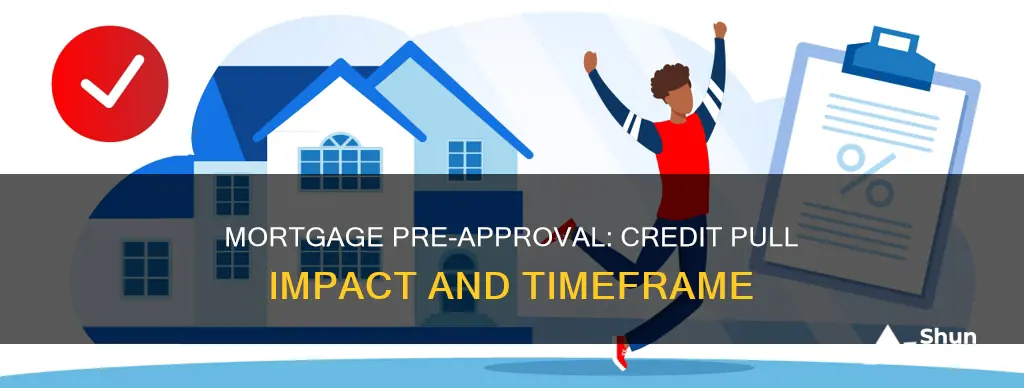
When applying for a mortgage, it is recommended to compare at least three different lenders to find the ideal combination of loan type, interest rate, and fees. Applying for mortgage pre-approval with multiple lenders within 14 days will show up on your credit report as a single hard credit pull, minimizing the impact on your credit score. However, if your pre-approvals are spread out over a longer period, each hard inquiry could cause small dips in your credit score. Therefore, it is best to apply for pre-approval with multiple lenders simultaneously to make an informed decision and secure the best rates and terms for your mortgage.
| Characteristics | Values |
|---|---|
| Time taken to receive preapproval letter | 1-3 business days, sometimes same day or instantly online |
| Preapproval validity | 60-90 days |
| Number of lenders to compare | At least 3 |
| Preapproval vs prequalification | Preapproval is a more thorough evaluation and involves submitting documentation about your finances |
| Preapproval vs qualification | Preapproval is a conditional approval, not a guarantee of a mortgage |
| Multiple preapprovals | Applying to multiple lenders within 14 days will show up as one hard credit pull |
What You'll Learn

Preapproval vs prequalification
Preapproval and prequalification are both types of mortgage approvals. They are indications from a mortgage lender that you are eligible for a mortgage. However, preapproval is a more thorough evaluation and involves submitting documentation about your finances.
Prequalification is a simple, quick process that provides a general indication of whether you would qualify for a mortgage. It is a basic assessment of your credit and finances and gives you an idea of what you might qualify for. It is often done in person with a loan officer on the spot, or immediately online. You will be required to provide information about your income and assets, but you won't be required to provide any documents. Prequalification is an early step in your homebuying journey and can be useful if you are not sure whether you would qualify for a mortgage or how much you would want to spend.
Preapproval, on the other hand, requires extensive financial documentation and provides a much firmer maximum loan amount. It is a more in-depth process than prequalification and requires you to provide information or documents such as pay stubs, tax returns, bank statements, and your Social Security card. Preapproval is as close as you can get to confirming your creditworthiness without having a purchase contract in place. It is a smart step to take when you are ready to put in an offer on a home.
It is important to note that neither prequalification nor preapproval guarantees that you will close the loan. They are both a way for a lender to help you and a seller estimate what you can afford. While you can get prequalified or preapproved by multiple lenders, it is generally recommended to compare at least three lenders to find the ideal combination of loan type, interest rate, and fees that meets your needs.
Lower Fees, Bigger Benefits: Refinancing Your Mortgage
You may want to see also

How many preapprovals
When it comes to mortgage pre-approval, there is no one-size-fits-all answer to how many pre-approvals you should apply for. However, it is generally recommended to compare offers from multiple lenders to find the best loan terms and rates. According to the Consumer Financial Protection Bureau (CFPB), you should compare at least three different lenders when applying for a mortgage.
Getting pre-approved by multiple lenders allows you to compare rates, fees, and loan terms side by side, helping you identify the most affordable loan for your needs. It also gives you a sense of which lender you feel most comfortable working with, as each lender has its own approach to customer service and the loan application process.
It's important to note that when you request a pre-approval, the lender usually performs a "hard" credit check, which can lower your credit score by a small amount. However, credit scoring models typically group multiple mortgage inquiries together as one, as long as they occur within a 45-day period. This means that you can shop around for the best rates and lenders without significantly impacting your credit score.
Additionally, pre-approval is not the same as pre-qualification. Pre-qualification is a basic assessment of your credit and finances, often done online or with a loan officer, and gives you an idea of what you might qualify for. On the other hand, pre-approval is a more thorough evaluation that involves submitting documentation about your finances, and it allows you to make offers on homes.
In summary, while there is no definitive answer to how many pre-approvals you should apply for, it is recommended to compare at least three different lenders to find the best loan terms and rates, and to ensure you are comfortable with the lender you choose.
The Yield Curve: Mortgage Rates and Impact
You may want to see also

Credit score impact
Mortgage pre-approval does impact your credit score, but only temporarily. When a lender checks your credit for a mortgage pre-approval, they run a "hard inquiry" or a "hard pull", which can cause your score to dip slightly. This is because the lender reviews your credit reports and financial documents to determine the loan amount and interest rate you could receive. However, the impact on your credit score is likely to be minimal and short-lived, and the benefits of pre-approval, such as setting a realistic budget and demonstrating to sellers that you are a serious buyer, usually outweigh the small drop in your score.
A hard inquiry is when a lender checks your credit to make a lending decision, and it will be recorded on your credit report. While hard inquiries can stay on your credit report for up to two years, they only impact your credit score for one year, and the impact diminishes over time. FICO, for example, only considers inquiries from the last 12 months when calculating your score. Additionally, if you apply for multiple loans of the same type within a short period, credit bureaus will likely treat multiple hard inquiries as a single inquiry to minimize the impact on your credit score. According to FICO, if you submit multiple applications requiring a hard credit pull for a mortgage within a 30-day window, they will only count as one credit event.
It is important to note that there is another type of credit inquiry called a "soft inquiry" or "soft pull", which does not impact your credit score. A soft inquiry occurs when a lender only wants to provide a rate quote, or when they are deciding whether to pre-approve you for a credit card. Soft inquiries are also performed when you check your own credit report.
Although mortgage pre-approval can cause a slight drop in your credit score, it is an important step in the home-buying process. By getting pre-approved, you can determine how much you can afford to borrow, which helps you set a realistic budget for your home search. A pre-approval letter also demonstrates to sellers that you are a qualified buyer with the funds to see the purchase through to closing, making your offers more appealing.
Capital Gains and Mortgage: What's the Connection?
You may want to see also

Preapproval expiry
Mortgage preapproval is beneficial for home buyers for several reasons. It helps buyers search for homes within their budget, making for a smoother and more efficient house hunt. It also makes an offer more enticing to a seller, and gets a bulk of the mortgage process done early on.
Mortgage preapproval typically lasts for 60 to 90 days, depending on the lender. After that, you’ll need to apply again with another credit pull and updated paperwork. If there are any major changes to your financial situation, your preapproval limit might also change.
If your preapproval expires, you will have to reapply, which will have an impact on your credit score. However, this typically doesn’t take too much time since lenders will have most of your information on file.
It is recommended that you apply for a mortgage preapproval when you’re actively house hunting, but not so far in advance that you risk your preapproval expiring. It is also important to note that, while you can get multiple preapproval letters, it can hurt your credit if you don’t have your credit pulls done during a 2-week period.
It is also worth noting that preapproval is different from prequalification. Prequalification is an early step in your homebuying journey, where you get an estimate of what you might be able to borrow, based on information you provide about your finances, as well as a credit check. Preapproval, on the other hand, is a more thorough evaluation and involves submitting documentation about your finances. A preapproval letter allows you to make offers on homes, while a prequalification does not.
Mortgage-Backed Securities: Boosting Economy Through Homeownership
You may want to see also

Preapproval process
The preapproval process for a mortgage is an important step in the home-buying journey. It involves a thorough review of your financial information by a lender, who will assess your eligibility for a mortgage loan. Here is a step-by-step guide to the preapproval process:
Step 1: Understand the Difference Between Pre-Qualification and Preapproval
Pre-qualification is an early, informal step where a lender estimates how much you might be able to borrow based on a basic overview of your finances. Preapproval, on the other hand, is a more specific and formal estimate of your borrowing capacity and requires detailed financial documentation.
Step 2: Gather Necessary Documentation
Before initiating the preapproval process, ensure you have the required documents. This includes proof of income (such as pay stubs, W-2 forms, or tax returns), asset documentation (statements for checking, savings, and investment accounts), Social Security numbers, and tax forms.
Step 3: Contact Lenders and Ask Questions
Reach out to lenders to understand their specific requirements and processes. Ask questions to clarify any assumptions they make during preapproval and address any potential issues. Remember that each lender is different, so it's essential to gather information and compare their offerings.
Step 4: Submit Documentation and Financial Information
Provide the lender with the requested documentation and detailed financial information. This may include income verification, employment history, debt obligations, and assets. Be prepared to answer questions about your finances, such as loan payments or credit card usage.
Step 5: Receive Preapproval Letter
After reviewing your documentation and financial details, the lender will provide you with a preapproval letter. This letter outlines the maximum amount you are eligible to borrow and demonstrates your financial readiness to sellers. Keep in mind that preapproval letters typically have an expiration date, ranging from 30 to 90 days, after which you may need to renew it with updated financial information.
Step 6: Shop for Homes Within Your Budget
With your preapproval letter in hand, you can now start looking for homes that match your financial capabilities. A real estate agent can assist you in finding properties that fit within the budget specified in your preapproval letter. Remember that preapproval does not commit you to a specific lender, and you can still decide on a lender later in the process.
Step 7: Make an Offer and Finalize Your Loan
Once you've found a home you wish to purchase, you can make a stronger offer to the seller, knowing that you have already secured preapproval. After your offer is accepted, you can decide on a lender and receive official Loan Estimates from your potential lenders. Remember to consider the interest rates and costs associated with the loan, as these can vary between lenders.
In summary, the preapproval process involves gathering and submitting financial documentation, receiving a preapproval letter, and then using that letter to shop for homes within your budget. It is an essential step in the home-buying process, providing you with a competitive advantage and helping you make more informed decisions about your future purchase.
United Wholesale Mortgage: Revenue Streams and Business Model
You may want to see also
Frequently asked questions
It is recommended that you compare at least three different lenders when applying for a mortgage.
Prequalification is a basic assessment of your credit and finances, while preapproval is a more thorough evaluation that involves submitting documentation about your finances. Prequalification gives you an idea of what you might qualify for, whereas preapproval determines how much you can borrow.
A mortgage preapproval typically lasts for 60-90 days, depending on the lender. After that, you will need to apply again with another credit pull and updated paperwork.
If you apply for preapproval with multiple mortgage lenders over just 14 days, it will show up on your credit report as only one hard credit pull. However, if your pre-approvals are spread out over a longer period, each hard inquiry could cause small dips in your credit score.







